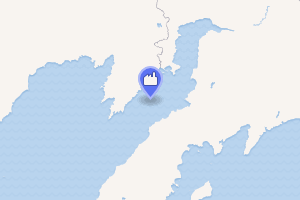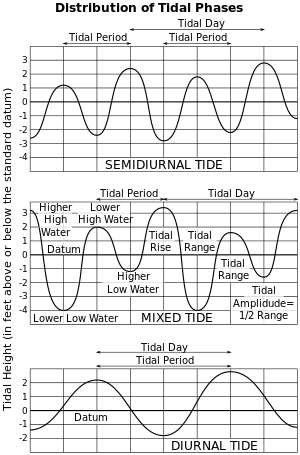Penzhin Tidal Power Plant Project
The Penzhin Tidal Power Plant Project is a set of proposals for construction of tidal power plant in the Penzhin Bay, which is an upper right arm of Shelikhov Bay in the north-east corner of the Sea of Okhotsk. Because Penzhin Bay has one of the strongest tides in the world, there have been several proposals of power stations. One of proposed variants presumes an installed capacity 87 GW and annual production 200 TWh of electricity.[1]
| Penzhin Tidal Power Plant | |
|---|---|

| |
| Country | Russia |
| Location | Penzhin Bay |
| Coordinates | 61°N 162°E |
| Status | Proposed |
Geographically, the dam of the power station would extend through the administrative border of Magadan Oblast and Kamchatka Krai of Russia.
General information
The tides in Penzhin Bay are 9 metres (30 ft) high, and reach 12.9 metres (42 ft) in the case of spring tides, which is the highest magnitude for the Pacific Ocean. As the area of the bay basin is 20,530 km2 (7,930 mi2), it corresponds to diurnal discharge of 360–530 km3 (86–130 cu mi). This water rate is 20–30 times higher than that of the world's biggest river, the Amazon River. Two projects were developed for tidal power stations. The first would use the entire basin of the bay. The second proposes a smaller-scale plant, using the northern part of the basin with higher tides:[2]
| Variant | Tide altitude, m / ft | Capacity, GW | Annual production, TW·h | Time of research |
|---|---|---|---|---|
| South site | 11 / 36 | 87,1 | 190–205 | 1972—1996 |
| North site | 13.4 / 44 | 21,4 | 50 | 1983—1996 |
Due to the lack of existing local energy consumers or long-distance power distribution infrastructure, there are suggestions of a discrete work of the station to supply power-consuming production. One such consumer, for example, would be the production of liquid hydrogen.
Hydrological potential of the bay

The tides in the Penzhin Bay of the Sea of Okhotsk are the highest for the Pacific Ocean, reaching a height of 13.4 metres (44 ft).[3] The tides in Shelikhov Bay are of the diurnal type. The area of Penzhin Bay basin is 20,530 km2.[2][4] Given that the average magnitude of tide is equal to 10 metres (33 ft), this gives the diurnal flow of water in the bay as 410.6 cubic kilometres (98.5 cu mi) or average discharge 4.75×106 m3•s−1.
The passing stream has its own potential energy, which in the gravity field of Earth is above zero only in the case of non-zero head of water () and can be expressed as follows:
- , (1)
where denotes potential energy; — density of sea water, equal to 1,027 kg/m3; — area of basin; — height of the tide and — gravitational acceleration, set to 9.81 m/s2. The part of the expression in brackets denotes terms defining the mass of water passing through the basin daily.
As can be seen in formula (1), the potential energy becomes zero in the case of zero head of water and in the case of equal heights of head and tide. If considering this formula as a function of head level (), it has a form of parabolic dependence, with its maximum at = 2• or at m. This value of gives two times lower height of tide in the bay and twice smaller average discharge of water — 5 m and 2.38×106 m3•s−1 (205.3 km3/day), correspondingly.
The substitution of obtained parameters into (1) and dividing it by the day length in seconds gives the average capacity 120 GW. The latter one yields 1,054 TW•h or 3.79×1018 Joules of energy annually. Depending on the efficiency of conversion of potential energy into electricity, the total quantity of electricity and electric capacity will have somewhat lower values. If one assumes an efficiency of conversion of 96%, this gives an average electric capacity of 115 GW and an available amount of electricity of 1,012 TW•h or 3.64×1018 J per year.
References
- Usachev, I. N.; Shpolyanskiy, Y. B.; Istorik, B. L.; Kuznetsev, V. P.; Fateev, V. N.; Knyazev, V. A. (2008). Приливные электростанции (ПЭС) — источник энергии, запасаемый в водороде [Tidal power plants (TPP) — a source of energy, store-able in hydrogen] (PDF). 2nd International Forum "Hydrogen technologies for developing world" (in Russian). Moscow. Archived from the original (PDF) on 2011-08-17. Retrieved 2010-12-24.
- Ageev, V. A. "13. Использование энергии приливов и морских течений" (PDF). Нетрадиционные и возобновляемые источники энергии [Using the energy of tides and sea currents] (in Russian). Retrieved 2010-12-24.
- Savchenkov, S. N. (2010-04-15). Опыт проектирования приливных электростанций на Северо-Западе России [Experience in design of tidal power in North-West Russia] (PDF). International Congress "Clean Energy Days in Saint Petersburg" (in Russian). Archived from the original (PDF) on 2011-09-10. Retrieved 2010-12-24.
- Энциклопедия «География» [Encyclopedia of Geography] (in Russian). Retrieved 2010-12-24.